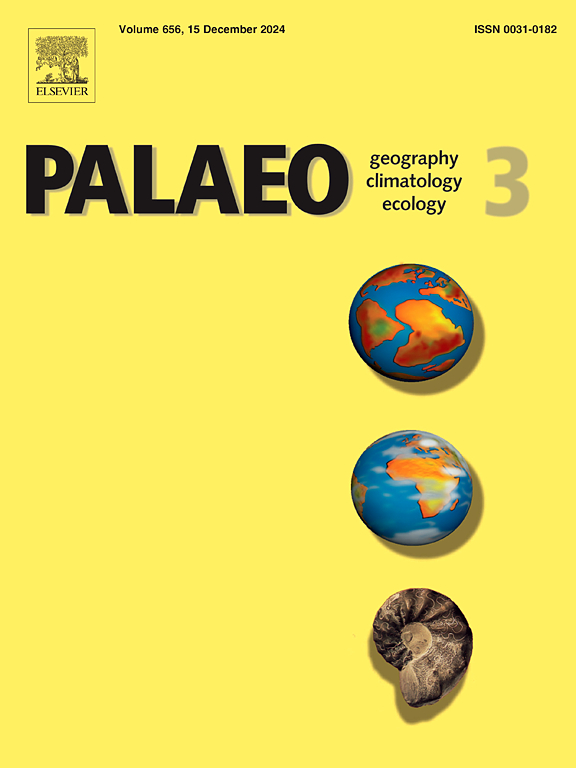High-frequency glacial climate instability during the Early Pleistocene: Insights from IODP site U1387 (Gulf of Cadiz)
IF 2.7
2区 地球科学
Q2 GEOGRAPHY, PHYSICAL
Palaeogeography, Palaeoclimatology, Palaeoecology
Pub Date : 2025-05-20
DOI:10.1016/j.palaeo.2025.113041
引用次数: 0
Abstract
We provide new high-resolution data on alkenone-derived sea surface temperature (SST) and calcareous plankton key taxa in temporally well constrained, high resolution benthic and planktonic oxygen isotope records at Integrated Ocean Drilling Program site U1387 in the Gulf of Cadiz. The investigated time interval encompasses the Early Pleistocene marine isotope stages (MIS) 48 to MIS 43. The aim is to evidence millennial climate variability during glacial phases of the “41 kyr world” and understand the impact of North Atlantic climate dynamics on the southern Portuguese margin. Neogloboquadrina pachyderma and Coccolithus pelagicus ssp. pelagicus record prominent, short-term abundance peaks concurrent with short-term SST minima and heavier values of ™18O in late MIS 48 and in the middle of MIS 46 and MIS 44. Superimposed on the obliquity and precession forcing, the wavelet analysis carried out on selected proxies (planktonic ™18O, N. pachyderma, C. pelagicus ssp. pelagicus, alkenone derived sea surface temperature) highlighted the occurrence of a higher frequency climate variability (<7 ky) mostly in glacial time windows and recalling the millennial-scale climate oscillations known from the Middle and Late Pleistocene. These brief colder episodes in the Gulf of Cadiz were contemporary to the weakening of the Atlantic Meridional Overturning Circulation, water column stratification, and Ice Rafted Detritus (IRD) events in the IRD belt as recorded in paleoenvironmental proxies from northern Atlantic reference sites, evidencing a southward shift of the subarctic front and European icesheet instability. At site U1387, they have been interpreted as terminal stadial (in late MIS 48) and stadial events (in MIS 46 and MIS 44) indicating that the millennial-scale variability during the early Pleistocene was strong enough to affect the mid-latitudes of the southern Portuguese margin.
早更新世高频冰川气候不稳定性:来自IODP站点U1387(加的斯湾)的启示
我们在加的斯湾综合海洋钻探项目U1387站点提供了新的高分辨率的烷烃源海表温度(SST)数据和石灰质浮游生物关键分类群,高分辨率的底栖生物和浮游生物氧同位素记录。研究的时间间隔包括早更新世海洋同位素阶段(MIS) 48至MIS 43。其目的是证明“41凯尔世界”冰期千年气候变化的证据,并了解北大西洋气候动态对葡萄牙南部边缘的影响。厚皮新红球蛾和球蛾。在MIS 48后期、MIS 46中期和MIS 44中期,中华鲟记录了显著的短期丰度峰值,同时记录了短期海温最小值和更高的™18O值。在倾角和进动强迫的叠加下,对浮游生物(浮游生物™18O)、厚皮藻(N. pachyderma)、pelagicus (C. pelagicus ssp.)进行了小波分析。{{{{{}} {{{}} {{{}} {{}} {{}} {{}}} {{}} {{}}} {{}} {{}}} {{}}} {{}}} {{}}} {{}}} {{}}}} {{}}} {{}}}} {{}}}} {{}}}} {{}}}加的斯湾这些短暂的变冷事件与大西洋经向翻转环流的减弱、水柱分层和IRD带的冰筏碎屑(IRD)事件(根据北大西洋参考地点的古环境代用物记录)是同时代的,证明了亚北极锋的南移和欧洲冰原的不稳定。在U1387遗址,它们被解释为终末的标准事件(MIS 48晚期)和标准事件(MIS 46和MIS 44),表明更新世早期的千年尺度变率足以影响葡萄牙南部边缘的中纬度地区。
本文章由计算机程序翻译,如有差异,请以英文原文为准。
求助全文
约1分钟内获得全文
求助全文
来源期刊
CiteScore
5.90
自引率
10.00%
发文量
398
审稿时长
3.8 months
期刊介绍:
Palaeogeography, Palaeoclimatology, Palaeoecology is an international medium for the publication of high quality and multidisciplinary, original studies and comprehensive reviews in the field of palaeo-environmental geology. The journal aims at bringing together data with global implications from research in the many different disciplines involved in palaeo-environmental investigations.
By cutting across the boundaries of established sciences, it provides an interdisciplinary forum where issues of general interest can be discussed.

 求助内容:
求助内容: 应助结果提醒方式:
应助结果提醒方式:


